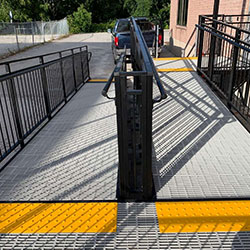









As cities continue to grow and evolve, it is more crucial than ever to ensure the security and accessibility of public areas. Tactile Walking Surface Indicators (TWSIs) installation is a vital step in enhancing the mobility and safety of pedestrians.
With the installation of TWSI, visually impaired individuals can navigate unfamiliar surrounding safely and confidently. These indicators serve as a tangible communication channel, bridging the gap between the built environment and the needs of pedestrians with disabilities.
In Canada, the use of tactile walking surface indicators is mandatory as per the Accessibility for Ontarians with Disabilities Act (AODA). To learn more about TWSI and how they contribute to safer pedestrian traveling, read out the blog post:
TWSIs, also known as tactile paving or detectable warning plates, are standardized patterns of textured ground surfaces that provide sensory feedback to pedestrians with visual impairments.
These indicators consist of raised truncated domes or bars that can be felt underfoot or detected with a mobility cane. It provides sensory feedback to individuals, alerting them to potential hazards or guiding them along a designated path. By enhancing navigation and safety, TWSIs serve as a valuable tool for visually impaired pedestrians.
TWSI, or detectable warning surfaces, are installed on sidewalks for pedestrians to provide individuals with visual impairments with important sensory information. These indicators help people with navigation, hazard identification, and direction. Using TWSI, visually impaired people can travel safely and more comfortably through the public spaces.
TWSI not only helps with navigation but also acts as a warning system for pedestrian crossings and hazardous areas. TWSI's distinctive patterns and colors might serve as a warning to pedestrians of the existence of busy intersections, railway crossings, or areas with potential dangers.
The AODA Act, implemented in Ontario, Canada, aims to make the province accessible for individuals with visual disabilities. As part of the act, it is mandatory to use TWSI in certain public spaces to ensure the safety and accessibility of pedestrian pathways. By incorporating TWSI, the AODA Act emphasizes the importance of inclusivity and equal opportunities for everyone, regardless of their abilities.
Tactile walking surface indicators (TWSIs) are essential for improving the accessibility and independence of individuals with visual impairments.
By providing tactile cues and underfoot feedback, TWSIs enable pedestrians to detect changes in their path, such as upcoming intersections, stairs, or other potentially dangerous areas. These indicators consist of detectable, raised patterns that are easily identifiable by touch, allowing visually impaired individuals to navigate confidently and efficiently.
The main goal of Tactile Walking Surface Indicators (TWSIs) is to enhance safety and minimize risks for pedestrians, especially those with visual impairments. By incorporating tactile indicators at specific locations, such as curb ramps and transit stops, potential hazards can be effectively communicated to individuals relying on their sense of touch.. This proactive safety measure plays a crucial role in preventing accidents and creating a more inclusive environment for all people.
The implementation of TWSIs, in accordance with the Accessibility for Ontarians with Disabilities Act (AODA) and its guidelines, brings consistency and standardization to public spaces. These indicators are carefully designed to ensure uniformity and ease of recognition, allowing individuals to navigate confidently and independently.
By adhering to the guidelines set forth by the AODA, businesses can create a harmonized environment where TWSIs are consistently present and appropriately placed. This consistency helps individuals with visual impairments develop a mental map of their surroundings, enhancing their ability to navigate public spaces with greater confidence and safety.
TWSIs are utilized in a variety of locations to provide crucial information to pedestrians with visual impairments. Here are some key areas where the use of tactile indicators is common:
Crosswalks and intersections are high-traffic areas where pedestrians need clear and concise cues to navigate safely. TWSIs are employed to mark crosswalks, signaling pedestrians when they have reached a designated crossing point. These indicators often feature distinctive patterns, such as truncated domes, to differentiate them from the surrounding surfaces.
Transit platforms and stations can be challenging environments with multiple pathways, stairs, and boarding areas. Tactile walking surface indicators are strategically placed to direct people to boarding zones, ticket booths, and other essential points of interest within the transit system. This enables visually impaired commuters to confidently navigate public transportation networks.
Pedestrian islands and medians help divide busy roadways, offering pedestrians a safe space to pause during their journey. TWSIs are incorporated into these areas to alert individuals with visual impairments of the separation between vehicle lanes. By providing tactile guidance, these indicators facilitate the decision-making process when crossing multiple lanes of traffic.
TWSI plays a significant role in the government buildings, such as city halls and libraries, and other public spaces, such as parks and sidewalks, to help people with visual impairments safely and independently navigate these environments.
Installing TWSIs is a crucial step in making pedestrian traveling safer. Not only does it help to meet legal requirements, but it also improves safety and navigation for all pedestrians.
At Tactile Solutions, we are committed to providing reliable, superior-quality TWSIs that meet or exceed all relevant regulations and specifications. We offer a variety of colors, shapes, and sizes to meet the specific needs of each project. In addition, our TWSIs are designed for easy installation and long-lasting performance, ensuring that contractors or businesses can meet their accessibility obligations with confidence.
